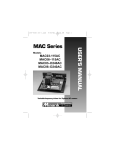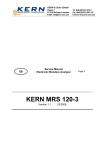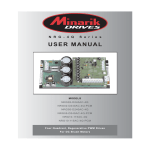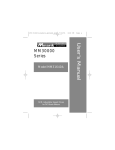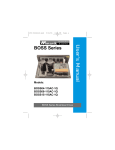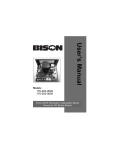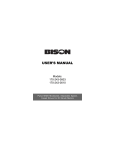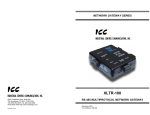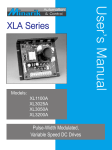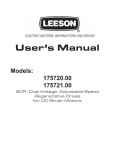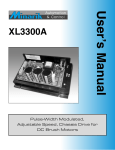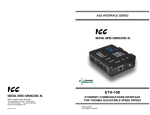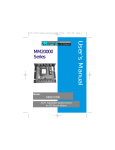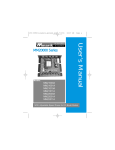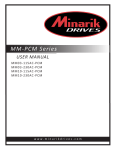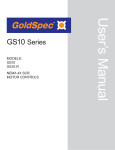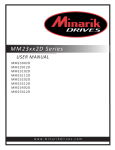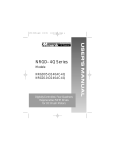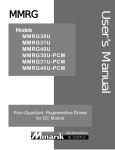Download User`s Manual - Minarik Drives
Transcript
250-0246r2_readers.qxd 6/7/01 Page a User’s Manual NRG–2Q Series 10:51 AM Two Quadrant, Regenerative PWM Drives for DC Brush Motors 250-0246r2_readers.qxd 6/7/01 10:51 AM Page b Copyright © 2001 by Minarik Corporation All rights reserved. No part of this manual may be reproduced or transmitted in any form without written permission from Minarik Corporation. The information and technical data in this manual are subject to change without notice. Minarik Corporation and its Divisions make no warranty of any kind with respect to this material, including, but not limited to, the implied warranties of its merchantability and fitness for a given purpose. Minarik Corporation and its Divisions assume no responsibility for any errors that may appear in this manual and make no commitment to update or to keep current the information in this manual. Printed in the United States of America. 250-0246r2_readers.qxd 6/7/01 10:51 AM Page i i Safety Warnings • This symbol denotes an important safety tip or warning. Failure to heed these warnings may result in damage to the drive or personal injury. Please read these instructions carefully before performing any of the procedures contained in this manual. • DO NOT INSTALL, REMOVE, OR SERVICE THIS EQUIPMENT WITH POWER APPLIED. Have a qualified electrical technician install, adjust and service this equipment. Follow the National Electrical Code and all other applicable electrical and safety codes, including the provisions of the Occupational Safety and Health Act (OSHA), when installing equipment. • Reduce the chance of an electrical fire, shock, or explosion by proper grounding, over-current protection, thermal protection, and enclosure. Follow sound maintenance procedures. It is possible for a drive to run at full speed as a result of a component failure. Minarik strongly recommends the installation of a master switch in the main power input to stop the drive in an emergency. Circuit potentials are at 115 VAC or 230 VAC above earth ground. Avoid direct contact with the printed circuit board or with circuit elements to prevent the risk of serious injury or fatality. Use a non-metallic screwdriver for adjusting the calibration trimpots. Use approved personal protective equipment and insulated tools if working on this drive with power applied. 250-0246r2_readers.qxd 6/7/01 10:51 AM Page ii ii Contents Specifications 1 NRG02–D240AC–2Q . . . . . . . . . . . . . . . . . . . . . . . . . . . . . . . . . . . . . . . . .1 NRG05–D240AC–2Q . . . . . . . . . . . . . . . . . . . . . . . . . . . . . . . . . . . . . . . . .2 NRG10–115AC–2Q . . . . . . . . . . . . . . . . . . . . . . . . . . . . . . . . . . . . . . . . . .3 Dimensions 4 Regenerative Drives 5 Installation 7 Drive mounting . . . . . . . . . . . . . . . . . . . . . . . . . . . . . . . . . . . . . . . . . . . . .7 Wiring . . . . . . . . . . . . . . . . . . . . . . . . . . . . . . . . . . . . . . . . . . . . . . . . . . . . .8 Shielding guidelines . . . . . . . . . . . . . . . . . . . . . . . . . . . . . . . . . . . . . . . .9 Line fusing . . . . . . . . . . . . . . . . . . . . . . . . . . . . . . . . . . . . . . . . . . . . . . . .10 Connections . . . . . . . . . . . . . . . . . . . . . . . . . . . . . . . . . . . . . . . . . . . . . . .11 Motor connections . . . . . . . . . . . . . . . . . . . . . . . . . . . . . . . . . . . . . . . .11 Power lead connections . . . . . . . . . . . . . . . . . . . . . . . . . . . . . . . . . . . .12 Dynamic brake resistor connections . . . . . . . . . . . . . . . . . . . . . . . . . . .12 Inhibit personality header . . . . . . . . . . . . . . . . . . . . . . . . . . . . . . . . . . . . .14 +12 VDC terminals . . . . . . . . . . . . . . . . . . . . . . . . . . . . . . . . . . . . . . . . . .14 Voltage follower connection . . . . . . . . . . . . . . . . . . . . . . . . . . . . . . . . . . .16 Operation Before applying power . . . . . . . . . Startup and shutdown . . . . . . . . . Starting and stopping methods . . . Line starting and stopping . . . . Decelerating to minimum speed Inhibit terminals . . . . . . . . . . . . Dynamic braking . . . . . . . . . . . . . . . . . . . . . . . . . . . . . . . . . . . . . . . . . . . . . . . . . . . . . . . . . . . . . . . . . . . . . . . . . . . . . . . . . . . . . . . . . . . . . . . . . . . . . . . . . . . . . . . . . . . . . . . . . . . . . . . . . . . . . . . . . . . . . . . . . . . . . . . . . . . . . . . . . . . . . . . . . . . . . . . . . . . . . . . . . . . . . . . . . . . . . . . . . . . . . . . . . . . . . . . 17 .17 .18 .19 .20 .21 .22 .23 250-0246r2_readers.qxd 6/7/01 10:51 AM Page iii iii Calibration Calibration procedure . . . . . . . . . . . . . . . . . . . . . . . . MINIMUM SPEED (MIN) . . . . . . . . . . . . . . . . . . . MAXIMUM SPEED (MAX) . . . . . . . . . . . . . . . . . . REGULATION (IR COMP) . . . . . . . . . . . . . . . . . . MOTOR CURR. LIMIT and REGEN CURR. LIMIT ACCEL . . . . . . . . . . . . . . . . . . . . . . . . . . . . . . . . DECEL . . . . . . . . . . . . . . . . . . . . . . . . . . . . . . . . . . . . . . . . . . . . . . . . . . . . . . . . . . . . . . . . . . . . . . . . . . . . . . . . . . . . . . . . . . . . . . . . . . . . . . . . . . . . . . . . . . . . . . . . . . . . . . . . . . . . . . . . . 26 .28 .29 .29 .30 .31 .32 .33 Application Notes Connection to other Minarik devices . . . . . . . . . . . . . Optional speed adjust potentiometer connections . . . Multiple fixed speeds . . . . . . . . . . . . . . . . . . . . . . Adjustable speeds using potentiometers in series Independent adjustable speeds . . . . . . . . . . . . . . RUN/JOG switch . . . . . . . . . . . . . . . . . . . . . . . . . . . RUN/JOG option #1 . . . . . . . . . . . . . . . . . . . . . . . RUN/JOG option #2 . . . . . . . . . . . . . . . . . . . . . . . Leader-follower application . . . . . . . . . . . . . . . . . . . . Single speed potentiometer control of multiple drives . . . . . . . . . . . . . . . . . . . . . . . . . . . . . . . . . . . . . . . . . . . . . . . . . . . . . . . . . . . . . . . . . . . . . . . . . . . . . . . . . . . . . . . . . . . . . . . . . . . . . . . . . . . . . . . . . . . . . . . . . . . . . . . . . . . . . . . . . . . . . . . . . . . . . . 35 .35 .36 .36 .37 .38 .39 .39 .40 .41 .42 Troubleshooting Before troubleshooting Diagnostic LEDs . . . . Power . . . . . . . . . . Motor Output . . . . . Regen Output . . . . Replacement Parts . . . . . . . . . . . . . . . . . . . . . . . . . . . . . . . . . . . . . . . . . . . . . . . . . . . . . . . . . . . . . . . . . . . . . . . . . . . . . . . . . . . . . . . . . . . . 43 .43 .44 .44 .44 .44 .49 Unconditional Warranty . . . . . . . . . . . . . . . . . . . . . . . . . . . . . . . . . . . . . . . . . . . . . . . . . . . . . . . . . . . . . . . . . . . . . . . . . . . . . . . . . . . . . . . . . . . . . . . . . . . . . . . . . . . . . . . . . . . . . . . . . . . . . . . . . . . . . . . . . . inside back cover 250-0246r2_readers.qxd 6/7/01 10:51 AM Page iv iv Illustrations Figure Figure Figure Figure Figure Figure Figure Figure Figure Figure 1. 2. 3. 4. 5. 6. 7. 8. 9. 10. Figure Figure Figure Figure Figure Figure Figure Figure 11. 12. 13. 14. 15. 16. 17. 18. NRG–2Q Dimensions . . . . . . . . . . . . . . . . . . . . . . . . . . . . . . . . . . . . .4 Two Quadrant Operation . . . . . . . . . . . . . . . . . . . . . . . . . . . . . . . . . .6 NRG–2Q Connections . . . . . . . . . . . . . . . . . . . . . . . . . . . . . . . . . . .13 Inhibit Personality Header, Inhibit Terminals and +12 VDC Terminals 15 Voltage Follower Connections . . . . . . . . . . . . . . . . . . . . . . . . . . . . .16 Connections for Run/Decelerate to Minimum Speed Switch . . . . . . .21 Dynamic Braking Circuit Connection . . . . . . . . . . . . . . . . . . . . . . . . .25 Calibration Trimpot Layout . . . . . . . . . . . . . . . . . . . . . . . . . . . . . . . .27 Typical IR COMP and CURRENT LIMIT settings . . . . . . . . . . . . . . .34 NRG-2Q Connection to DLC600 DIGI-LOK Control and PCM4 Signal Isolator . . . . . . . . . . . . . . . . . . . . . . . . . . . . . . . . .35 Multiple Fixed Speeds . . . . . . . . . . . . . . . . . . . . . . . . . . . . . . . . . . .36 Adjustable Fixed Speeds Using Potentiometers in Series . . . . . . . . .37 Independent Adjustable Speeds . . . . . . . . . . . . . . . . . . . . . . . . . . . .38 RUN/JOG Switch Connection to Inhibit Plug . . . . . . . . . . . . . . . . . . .39 RUN/JOG Switch Connection to Speed Adjust Potentiometer . . . . . .40 Leader-Follower Application . . . . . . . . . . . . . . . . . . . . . . . . . . . . . . .41 Single Speed Potentiometer Control of Multiple Drives . . . . . . . . . . .42 Diagnostic LED Location . . . . . . . . . . . . . . . . . . . . . . . . . . . . . . . . .44 Tables Table 1. Recommended Line Fuse Sizes . . . . . . . . . . . . . . . . . . . . . . . . . . . . .10 Table 2. Inhibit Plug Harness Assembly Part Number . . . . . . . . . . . . . . . . . . . .22 250-0246r2_readers.qxd 6/7/01 10:51 AM Page 1 1 Specifications Model Number NRG02–D240AC–2Q Type Open Chassis AC Line Voltage 115 VAC or 230 VAC, ±10%, 50Hz or 60 Hz, single phase Maximum Continuous Armature Current 2 ADC Horsepower Range @ 130 VDC Output 1/20 – 1/4 Horsepower Range @ 240 VDC Output 1/10 – 1/2 Maximum Armature Voltage Range @ 115 VAC Input 0–130 VDC Maximum Armature Voltage Range @ 230 VAC Input 0–240 VDC Form Factor 1.03 Acceleration Time Range 1–10 seconds Deceleration Time Range 1–10 seconds Input Signal Range (signal must be isolated) Input Impedance Speed Regulation (% of base speed) Speed Range Vibration 0–5 VDC 100K ohms minimum 1% open loop 100:1 0.5G max. (0–50 Hz); 0.1G max. (>50 Hz) Weight Ambient Operating Temperature Range 1.94 lb 10°C–40°C 250-0246r2_readers.qxd 2 6/7/01 10:51 AM Page 2 Specifications Model Number NRG05–D240AC–2Q Type Open Chassis AC Line Voltage 115 VAC or 230 VAC, ±10%, 50Hz or 60 Hz, single phase Maximum Continuous Armature Current 5 ADC Horsepower Range @ 130 VDC Output 1/8 – 3/4 Horsepower Range @ 240 VDC Output 1/4 – 1 1/2 Maximum Armature Voltage Range @ 115 VAC Input 0–130 VDC Maximum Armature Voltage Range @ 230 VAC Input 0–240 VDC Form Factor 1.03 Acceleration Time Range 1–10 seconds Deceleration Time Range 1–10 seconds Input Signal Range (isolated) 0–5 VDC Input Impedance 100K ohms minimum Speed Regulation (% of base speed) Speed Range Vibration 1% open loop 100:1 0.5G max. (0–50 Hz); 0.1G max. (>50 Hz) Weight Ambient Operating Temperature Range 1.94 lb 10°C–40°C 250-0246r2_readers.qxd 6/7/01 10:51 AM Page 3 Specifications Model Number NRG10–115AC–2Q Type AC Line Voltage 3 Open Chassis 115 VAC, ±10%, 50Hz or 60 Hz, single phase Maximum Continuous Armature Current 10 ADC Horsepower Range @ 130 VDC Output 1/4 – 1 1/2 Maximum Armature Voltage Range Form Factor 0–130 VDC 1.03 Acceleration Time Range 1–10 seconds Deceleration Time Range 1–10 seconds Input Signal Range (isolated) 0–5 VDC Input Impedance 100KW minimum Speed Regulation (% of base speed) Speed Range Vibration 1% open loop 100:1 0.5G max. (0–50 Hz); 0.1G max. (>50 Hz) Weight Ambient Operating Temperature Range 1.94 lb 10°C–40°C 250-0246r2_readers.qxd 6/7/01 10:51 AM Page 4 4 Dimensions D501 C506 C 503 L5 0 1 A1 C 501 DB- L503 AC C EL C 505 DEC EL C 502 4.44 [113] 4.44 [113] MAX 3.00 [76] 3.00 [76] L502 SO503 A2 M IN IN H IB IT PERSON ALITY 1 2 3 1&2=Dynam ic B rake 2& 3 = D isa b le O u tp u t R501 C504 DB+ TH501 MOTOR CURR. L IM IT R EG EN CURR. L IM IT BR1 IN H IB IT 0.70 0.70 [18] [18] AA FU502 MOTOR +12VDC + SO502 FU501 POWER SO501 OUTPUT S 1 S2 S3 L2-230V REGEN 2.20 [56] [56] 2.20 0.97 [25] [25] 0.97 6.30 [160] 6.30 [160] 6.90 [175] 6.90 [175] Model NRG02–D240AC–2Q NRG05–D240AC–2Q NRG10–115AC–2Q Dimension A 2.62 [67] 2.62 [67] 2.43 [62] All dimensions in inches [millimeters] Figure 1. NRG–2Q Dimensions L 1 L2- 115V GND IR C O M P 250-0246r2_readers.qxd 6/7/01 10:51 AM Page 5 5 Regenerative Drives Most non-regenerative, variable speed, DC drives control current flow to a motor in one direction. The direction of current flow is the same direction as the motor rotation. Non-regenerative drives operate in Quadrant 1 (see Figure 2, page 6). Unless dynamic braking is used, non-regenerative drives decelerate a load faster than coasting to a lower speed. NRG–2Q drives operate in Quadrants 1 and 4. In Quadrant 4, the direction of current flow is in the opposite direction of motor rotation. This allows regenerative drives to control an overhauling load and decelerate a load faster than it would take to coast to a lower speed. 250-0246r2_readers.qxd 6 6/7/01 10:51 AM Page 6 Regenerative Drives Figure 2. Two Quadrant Operation 250-0246r2_readers.qxd 6/7/01 10:51 AM Page 7 7 Installation Drive mounting Warning Do not install, rewire, or remove this control with power applied. Doing so may cause fire or serious injury. Make sure you have read and understood the Safety Warnings before attempting installation. The chassis must be earth grounded. Use a star washer beneath the head of at least one of the mounting screws to penetrate the anodized chassis surface and to reach bare metal. • Drive components are sensitive to electrostatic fields. Avoid contact with the circuit board directly. Hold drive by the chassis only. • Protect the drive from dirt, moisture, and accidental contact. Provide sufficient room for access to the terminal block and calibration trimpots. • Mount the drive away from other heat sources. Operate the drive within the specified ambient operating temperature range. • Prevent loose connections by avoiding excessive vibration of the drive. • Mount drive with its board in either a horizontal or vertical plane. Six 0.19 inch (5 mm) wide slots in the chassis accept #8 pan head screws. Fasten either the large base or the flange of the chassis to the subplate. 250-0246r2_readers.qxd 8 6/7/01 10:51 AM Page 8 Installation Wiring Warning Do not install, remove, or rewire this equipment with power applied. Failure to heed this warning may result in fire, explosion, or serious injury. Circuit potentials are at 115 or 230 VAC above ground. To prevent the risk of injury or fatality, avoid direct contact with the printed circuit board or with circuit elements. Do not disconnect any of the motor leads from the drive unless power is removed or the drive is disabled. Opening any one motor lead may destroy the drive. Use 16 AWG wire for AC line voltage (L1 and L2) and motor armature (A1 and A2) wiring. Use 18 AWG wire for logic (inhibit leads or S1, S2 and S3). For the dynamic brake resistor, use 14 AWG wire for model NRG10–115AC–2Q, or 16 AWG wire for models NRG05–D240AC–2Q and NRG02–D240AC–2Q. 250-0246r2_readers.qxd 6/7/01 10:51 AM Page 9 Installation 9 Shielding guidelines Warning Under no circumstances should power and logic leads be bundled together. Induced voltage can cause unpredictable behavior in any electronic device, including motor controls. As a general rule, Minarik recommends shielding of all conductors. If it is not practical to shield power conductors, Minarik recommends shielding all logic-level leads. If shielding logic leads is not practical, the user should twist all logic leads with themselves to minimize induced noise. It may be necessary to earth ground the shielded cable. If noise is produced by devices other than the drive, ground the shield at the drive end. If noise is generated by a device on the drive, ground the shield at the end away from the drive. Do not ground both ends of the shield. If the drive continues to pick up noise after grounding the shield, it may be necessary to add AC line filtering devices, or to mount the drive in a less noisy environment. 250-0246r2_readers.qxd 10 6/7/01 10:51 AM Page 10 Installation Line fusing NRG Series drives have preinstalled line fuses. See the Replacement Parts section for preinstalled line fuse size. When replacing the line fuses, use fast acting fuses rated for 250 VAC or higher, and approximately 150% of the armature current. Two line fuses are required for models NRG02–D240AC–2Q and NRG05–D240AC–2Q, while only one is required for model NRG10–115AC–2Q. See Table 1 for recommended line fuse sizes. Table 1. Recommended Line Fuse Sizes 90 VDC Motor 180 VDC Motor Max. DC Armature AC Line Fuse Horsepower Horsepower Current (amps) Size (amps) 1/20 1/15 1/8 1/6 1/4 1/3 1/2 3/4 1 1/10 1/8 1/4 1/3 1/2 3/4 1 1 1/2 2 0.5 0.8 1.5 1.7 2.6 3.5 5.0 7.6 10 3 3 5 5 8 8 10 15 20 Minarik Corporation offers two fuse kits: part number 050–0069 (3–8A Fuse Kit) and 050–0073 (5–20A Fuse Kit). See Replacement Parts (page 49) for fuse kit contents. 250-0246r2_readers.qxd 6/7/01 10:51 AM Page 11 Installation 11 Connections Warning Do not connect this equipment with power applied. Failure to heed this directive may result in fire or serious injury. Minarik strongly recommends the installation of a master power switch in the voltage input line. The switch contacts should be rated at a minimum of 200% of motor nameplate current and 250 volts. Connect the power input leads and a DC motor to the drive’s printed circuit board (PCB) as shown in Figure 3 (page 13). Motor connections Minarik drives supply motor voltage from A1 and A2 terminals. It is assumed throughout this manual that, when A1 is positive with respect to A2 , the motor will rotate clockwise (CW) while looking at the output shaft protruding from the front of the motor. If this is opposite of the desired rotation, simply reverse the wiring of A1 and A2 with each other. Connect a DC motor to PCB terminals A1 and A2 as shown in Figure 3. Ensure that the motor voltage rating is consistent with the drive’s output voltage. 250-0246r2_readers.qxd 12 6/7/01 10:51 AM Page 12 Installation Power lead connections Connect the AC line power leads to TB501 terminals L1 and L2, or to a double-throw, single-pole master power switch (recommended). Dynamic brake resistor connections If you plan to use dynamic braking to stop the motor, you must connect a dynamic brake resistor across the DB+ and DBterminals on the PCB as shown in Figure 3. The dynamic brake resistor reduces the voltage across the bus capacitors (C503 and C504) when they reach their maximum voltage rating. This occurs when the motor regenerates voltage back to the drive. Bus capacitor maximum voltage ratings are 400 VDC for 240 VAC drives, and 200 VDC for 115 VAC drives. For more information on dynamic braking, as well as selecting dynamic brake resistor values, refer to the Dynamic Braking section on page 23. 250-0246r2_readers.qxd 6/7/01 10:51 AM Page 13 Installation Also see Dynamic brake resistor sizing, page 23. Figure 3. NRG–2Q Connections 13 250-0246r2_readers.qxd 14 6/7/01 10:51 AM Page 14 Installation Inhibit personality header The inhibit personality header (SO503) determines how the drive responds when the INHIBIT terminals (SO501) are shorted together. Set the inhibit personality before shorting the inhibit terminal to each other. Jumper pins 1 and 2 for a dynamic brake response, or pins 2 and 3 for a disable output response (coast to a stop). (Also read Inhibit terminals section on page 22). See Figure 4 for jumper and inhibit terminal locations. +12 VDC terminals To supply power to external devices, the +12VDC terminals can supply an unregulated +12 VDC (30 mA) signal. – is the signal common terminal, and + is the voltage signal terminal. See Figure 4 for terminal location. 250-0246r2_readers.qxd 6/7/01 10:51 AM Page 15 Installation Inhibit Personality Header Inhibit Terminals +12 VDC Terminals Figure 4. Inhibit Personality Header, Inhibit Terminals, and +12 VDC Terminals 15 250-0246r2_readers.qxd 16 6/7/01 10:51 AM Page 16 Installation Voltage follower connection Instead of using a speed adjust potentiometer to set motor speed, the drive may follow a floating (isolated) 0 to +5 VDC signal. Connect the signal input to S2, and signal common to S1. Make no connection to S3. See Figure 5. Figure 5. Voltage Follower Connections 250-0246r2_readers.qxd 6/7/01 10:51 AM Page 17 17 Operation Warning Dangerous voltages exist on the drive when it is powered, and up to 30 seconds after power is removed and the motor stops. BE ALERT. High voltages can cause serious or fatal injury. Before applying power • Verify that no conductive material is present on the printed circuit board. • Set all switches and jumpers to their proper settings. • Verify that the AC supply is properly balanced. 250-0246r2_readers.qxd 18 6/7/01 10:51 AM Page 18 Operation Startup and shutdown 1. Set the speed adjust potentiometer for zero speed (full CCW). If the drive is following a voltage signal, set the voltage signal to 0 VDC. 2. Apply AC line voltage. 3. Rotate the speed adjust potentiometer or increase the voltage signal until the desired speed is reached. 4. Remove AC line voltage from the drive to coast the motor to a stop. 250-0246r2_readers.qxd 6/7/01 10:51 AM Page 19 Operation 19 Starting and stopping methods Warning Decelerating to minimum speed, regenerative braking, or coasting to a stop is recommended for frequent starts and stops. Do not use any of these methods for emergency stopping. They may not stop a drive that is malfunctioning. Removing AC line power (both L1 and L2) is the only acceptable method for emergency stopping. Frequent decelerating to minimum speed, regenerative braking, or coasting to a stop produces high torque. This may cause damage to motors, especially gearmotors that are not properly sized for the application. The 230 VAC line, if used, must be balanced. Contact your local distributor for line-balancing circuitry. Logic wires from other input devices, such as motion controllers and PLL velocity controllers must be separated from power lines in the same manner as the logic I/O on this drive. 250-0246r2_readers.qxd 20 6/7/01 10:51 AM Page 20 Operation Line starting and stopping When AC line voltage is applied to the drive, the motor accelerates to the set speed. When AC line voltage is removed, the motor coasts to a stop. Line stopping (removing AC line voltage) is recommended for stopping in emergency situations only. It is not recommended for frequent starting and stopping. For this reason, Minarik strongly recommends that you install a stop switch on the line voltage inputs (both L1 and L2). Refer to Figure 3 (page 13). Automatic restart of the drive When line voltage is applied to the drive, the motor will automatically accelerate to the speed commanded by the speed adjust potentiometer or reference signal. Wiring a latching relay into the motor control circuit is one way to prevent undesirable restarts. 250-0246r2_readers.qxd 6/7/01 10:51 AM Page 21 Operation 21 Decelerating to minimum speed Shorting terminal S2 to S1 decelerates the motor to minimum speed (Figure 6). The ACCEL and DECEL trimpots determine the rate of acceleration and deceleration, respectively. Set the minimum speed by calibrating the MIN trimpot. See Calibration on page 26 for specific calibration instructions Figure 6. Connections for Run/Decelerate to Minimum Speed Switch 250-0246r2_readers.qxd 22 6/7/01 10:51 AM Page 22 Operation Inhibit terminals Shorting the inhibit terminals (SO501) to each other causes the motor to either coast to a stop or brake to a stop. First set the inhibit personality to coasting or braking to a stop (see Inhibit personality on page 14). Next, short the inhibit pins to coast or brake to a stop. Remove the short to accelerate the motor to set speed. Minarik Corporation offers two accessory plug harnesses for use with the Inhibit terminals: Table 2. Inhibit Plug Harness Assembly Part Number Minarik Part Number Description 201-0024 201-0079 Inhibit plug with 18 in. (46 cm) wires Inhibit plug with 36 in. (91 cm) wires Twist inhibit plug wires and separate them from other powercarrying wires or sources of electrical noise. Use shielded cable if the inhibit plug wires are longer than 12 inches (30 cm). If shielded cable is used, ground only one end of the shield to earth ground. Do not ground both ends of the shield. 250-0246r2_readers.qxd 6/7/01 10:51 AM Page 23 Operation 23 Dynamic braking Warning Wait for the motor to completely stop before switching it back to RUN. This will prevent high armature currents from damaging the motor or drive. Inhibit personality header SO503 must be set to BRAKE for dynamic brake operation. See Figure 7, page 25. Dynamic braking may be used to rapidly stop a motor (Figure 7, page 25). Connect a RUN/BRAKE switch to the INHIBIT terminals. Connect a dynamic brake resistor to the DB+ and DB- terminals on the printed circuit board. See Figure 3 on page 13 for dynamic brake resistor connections. Dynamic brake resistor The dynamic brake resistor reduces the voltage across the bus capacitors (C503 and C504) when they reach their maximum voltage rating. This occurs when the motor regenerates voltage back to the drive. Bus capacitor maximum voltage ratings are 400 VDC for 240 VAC drives, and 200 VDC for 115 VAC drives. Dynamic brake resistor value Use a 40-ohm dynamic brake resistor for models NRG02-D240AC-2Q and NRG05-D240AC-2Q. Use a 20-ohm dynamic brake resistor for model NRG10-115AC-2Q. The dynamic brake resistor tolerance is ± 10%. 250-0246r2_readers.qxd 24 6/7/01 10:51 AM Page 24 Operation Dynamic brake resistor power rating Use the following equation to determine the dynamic brake resistor power rating: DBwatts = (Motor Power watts X duty cycle) X 1.2 = [(Horsepower X 746) X duty cycle] X 1.2 duty cycle = TREGEN TMOTOR + TREGEN where TREGEN is the amount of time the motor is generating voltage back into the drive, and TMOTOR is the amount of time the drive is generating voltage into the motor. The absolute minimum dynamic brake resistor power rating is typically 100 watts. Example: Size a DB resistor for a 1 HP motor that has a 50% duty cycle. It will be used with model NRG05–D240AC–2Q. Solution: Use a 40 ohm resistor with a minimum power rating of at least 448 watts. 250-0246r2_readers.qxd 6/7/01 10:51 AM Page 25 Operation Figure 7. Dynamic Braking Circuit Connection 25 250-0246r2_readers.qxd 6/7/01 10:51 AM Page 26 26 Calibration Warning Dangerous voltages exist on the drive when it is powered, and up to 30 seconds after power is removed and the motor stops. When possible, disconnect the voltage input from the drive before adjusting the trimpots. If the trimpots must be adjusted with power applied, use insulated tools and the appropriate personal protection equipment. BE ALERT. High voltages can cause serious or fatal injury. NRG-2Q Series drives have seven user-adjustable trimpots. Each drive is factory calibrated to its maximum current rating. Readjust the calibration trimpot settings to accommodate lower current motors. See Figure 8 for trimpot location. All adjustments increase with CW rotation and decrease with CCW rotation. Use a non-metallic screwdriver for calibration. Each trimpot is identified on the printed circuit board. 250-0246r2_readers.qxd 6/7/01 10:51 AM Page 27 Calibration ACCELERATION DECELERATION MAXIMUM SPEED MINIMUM SPEED MOTOR CURRENT LIMIT REGEN CURRENT LIMIT REGULATION (IR COMP) Figure 8. Calibration Trimpot Layout 27 250-0246r2_readers.qxd 28 6/7/01 10:51 AM Page 28 Calibration Calibration procedure Calibrate the drive using the following procedure: 1. Set the MIN SPD, MAX SPD, ACCEL and DECEL trimpots to zero (full CCW). 2. Set the MOTOR CURRENT LIMIT and REGEN CURRENT LIMIT trimpots to maximum (full CW). 3. Set the IR COMP trimpot to midrange (approximate 12 o’clock position). 4. Set the signal input (analog voltage signal or speed adjust potentiometer) to zero. 5. Apply power to the drive. 6. Calibrate the trimpots as follows: 250-0246r2_readers.qxd 6/7/01 10:51 AM Page 29 Calibration 29 MINIMUM SPEED (MIN) The MIN setting determines the minimum speed when the speed adjust potentiometer or voltage input signal is set for minimum speed. It is factory set to zero speed. To calibrate MIN: 1. Set the MIN trimpot CCW. 2. Set the speed adjust potentiometer or voltage input signal for minimum speed. 3. Adjust the MIN trimpot to the desired minimum speed. MAXIMUM SPEED (MAX) The MAX setting determines the maximum motor speed when the speed adjust potentiometer or voltage input signal is set for maximum speed. It is factory set for maximum rated motor speed. To calibrate MAX: 1. Set the MAX trimpot full CCW. 2. Set the speed adjust potentiometer or voltage input signal for maximum speed. 3. Adjust the MAX trimpot to the desired maximum speed. 250-0246r2_readers.qxd 30 6/7/01 10:51 AM Page 30 Calibration REGULATION (IR COMP) The IR COMP setting determines the degree to which motor speed is held constant as the motor load changes. It is factory set for optimum motor regulation at maximum rated current. To calibrate IR COMP (exact calibration): 1. Turn the IR COMP trimpot full CCW. 2. Set the speed adjust potentiometer or voltage input signal until the motor runs at midspeed without load (for example, 900 RPM for an 1800 RPM motor). Use a hand held tachometer to measure motor speed. 3. Load the motor armature to its full load armature current rating. The motor should slow down. 4. While keeping the load on the motor, rotate the IR COMP trimpot until the motor runs at the speed measured in step 2. Approximate calibration: If the motor does not maintain set speed as the load changes, gradually rotate the IR COMP trimpot CW. If the motor oscillates (overcompensation), the IR COMP trimpot may be set too high (CW). Turn the IR COMP trimpot CCW to stabilize the motor. See Figure 9, page 34 for recommended IR COMP trimpot settings. 250-0246r2_readers.qxd 6/7/01 10:51 AM Page 31 Calibration 31 MOTOR CURR. LIMIT and REGEN CURR. LIMIT Warning Although CURRENT LIMIT is set to 120% of motor nameplate current rating, continuous operation beyond that rating may damage the motor. If you intend to operate beyond the rating, contact your Minarik representative for assistance. The MOTOR CURR. LIMIT setting determines the maximum current limit for accelerating and driving the motor. The REGEN CURR. LIMIT setting determines the maximum current limit for decelerating and stopping the motor. Both CURRENT LIMIT trimpots are factory set at approximately 120% of maximum drive current and must be recalibrated when using a lower current motor.. See Figure 9, page 34, for recommended CURRENT LIMIT trimpot settings. To calibrate the CURRENT LIMIT trimpots: 1. With the power disconnected from the drive, connect a DC ammeter in series with the armature. 2. Set the MOTOR CURR. LIMIT trimpot to minimum (full CCW). 3. Lock the motor armature. Be sure that the motor is firmly mounted. 4. Connect power to the drive. The motor should remain stopped. 250-0246r2_readers.qxd 32 6/7/01 10:51 AM Page 32 Calibration 5. Set the speed adjust potentiometer or voltage input signal for maximum forward speed. 6. Slowly adjust the MOTOR CURR. LIMIT trimpot CW until the armature current is 120% of motor rated current. 7. Set the REGEN CURR. LIMIT trimpot to approximately the same setting as the MOTOR CURR. LIMIT. 8. Set the speed adjust potentiometer or voltage input signal for zero speed 9. Remove AC power. 10. Remove the stall from the motor. ACCEL The ACCEL setting determines the time the motor takes to ramp to a higher speed. ACCEL is factory set for the fastest acceleration time (full CCW). To calibrate ACCEL: 1. Set the speed adjust potentiometer or voltage input signal to zero speed. The motor should run at minimum speed. 2. Set the speed adjust potentiometer or voltage input signal to maximum forward speed, and measure the time it takes the motor to go from minimum to maximum speed. 3. If the time measured in step 2 is not the desired acceleration time, turn the ACCEL trimpot CW for a slower acceleration time, or CCW for a faster acceleration time. Repeat steps 1 through 3 until the acceleration time is correct. 250-0246r2_readers.qxd 6/7/01 10:51 AM Page 33 Calibration 33 DECEL The DECEL setting determines the time the motor takes to ramp to a lower speed. DECEL is factory set for the fastest deceleration time (full CCW). To calibrate DECEL: 1. Set the speed adjust potentiometer or voltage input signal to maximum forward speed. The motor should run at maximum speed. 2. Set the speed adjust potentiometer or voltage input signal to minimum speed and measure the time it takes the motor to go from maximum to minimum speed. 3. If the time measured in step 2 is not the desired deceleration time, turn the DECEL trimpot CW for a slower deceleration time, or CCW for a faster deceleration time. Repeat steps 1 through 3 until the deceleration time is correct. 250-0246r2_readers.qxd 34 6/7/01 10:51 AM Page 34 Calibration NRG10-115AC-2Q 1 HP 90 VDC 10 ADC IR COMP REGEN CURR. LIMIT MOTOR CURR. LIMIT IR COMP REGEN CURR. LIMIT MOTOR CURR. LIMIT 1/3 HP 90 VDC 3.5 ADC IR COMP REGEN CURR. LIMIT MOTOR CURR. LIMIT IR COMP REGEN CURR. LIMIT MOTOR CURR. LIMIT 1/2 HP 90 VDC 5 ADC 1/4 HP 90 VDC 2.5 ADC NRG05-D240AC-2Q NRG02-D240AC-2Q 1/2 HP 90 VDC 5 ADC IR COMP REGEN CURR. LIMIT MOTOR CURR. LIMIT IR COMP REGEN CURR. LIMIT MOTOR CURR. LIMIT IR COMP REGEN CURR. LIMIT MOTOR CURR. LIMIT IR COMP REGEN CURR. LIMIT MOTOR CURR. LIMIT IR COMP REGEN CURR. LIMIT MOTOR CURR. LIMIT IR COMP REGEN CURR. LIMIT MOTOR CURR. LIMIT IR COMP REGEN CURR. LIMIT MOTOR CURR. LIMIT IR COMP REGEN CURR. LIMIT MOTOR CURR. LIMIT 1/4 HP 90 VDC 2.5 ADC IR COMP REGEN CURR. LIMIT MOTOR CURR. LIMIT IR COMP REGEN CURR. LIMIT MOTOR CURR. LIMIT IR COMP REGEN CURR. LIMIT MOTOR CURR. LIMIT IR COMP REGEN CURR. LIMIT MOTOR CURR. LIMIT IR COMP REGEN CURR. LIMIT MOTOR CURR. LIMIT 1/3 HP 90 VDC 3.5 ADC 1/8 HP 90 VDC 1.3 ADC 1/4 HP 90 VDC 2.5 ADC 1/50 HP 90 VDC .28 ADC 1/8 HP 90 VDC 1.3 ADC 1/2 HP 180 VDC 2.5 ADC 1 HP 180 VDC 5 ADC 1/4 HP 180 VDC 1.4 ADC 3/4 HP 180 VDC 3.8 ADC 1/2 HP 180 VDC 2.5 ADC 1/4 HP 180 VDC 1.4 ADC Figure 9. Typical IR COMP and CURRENT LIMIT settings (actual settings may vary) 250-0246r2_readers.qxd 6/7/01 10:51 AM Page 35 35 Application Notes Connection to other Minarik devices S1 S1 NRG-2Q DRIVE DLC600 DIGI-LOK CONTROL S2 S2 S2 2 NRG-2Q DRIVE PCM4 SIGNAL ISOLATOR S1 1 Figure 10. NRG-2Q Connection to DLC600 DIGI-LOK Control and PCM4 Signal Isolator 250-0246r2_readers.qxd 36 6/7/01 10:51 AM Page 36 Application Notes Optional speed adjust potentiometer connections Multiple fixed speeds Replace the speed adjust potentiometer with series resistors with a total series resistance of 10K ohms (Figure 11). Add a single pole, multi-position switch with the correct number of positions for the desired number of fixed speeds. Figure 11. Multiple Fixed Speeds 250-0246r2_readers.qxd 6/7/01 10:51 AM Page 37 Application Notes 37 Adjustable speeds using potentiometers in series Replace the speed adjust potentiometer with a single pole, multi-position switch, and two or more potentiometers in series, with a total series resistance of 10K ohms. Figure 12 shows a connection for fixed high and low speed adjust potentiometers. Figure 12. Adjustable Fixed Speeds Using Potentiometers in Series 250-0246r2_readers.qxd 38 6/7/01 10:51 AM Page 38 Application Notes Independent adjustable speeds Replace the speed adjust potentiometer with a single pole, multiposition switch, and two or more potentiometers in parallel, with a total parallel resistance of 10K ohms. Figure 13 shows the connection of two independent speed adjust potentiometers that can be mounted at two separate operating stations. Figure 13. Independent Adjustable Speeds 250-0246r2_readers.qxd 6/7/01 10:51 AM Page 39 Application Notes 39 RUN/JOG switch Using a RUN/JOG switch is recommended in applications where quick and frequent jogging is required. Use a single pole, two position switch for the RUN/JOG switch, and a single pole, normally closed, momentary operated pushbutton for the JOG pushbutton. RUN/JOG option #1 In the first wiring option, connect the RUN/JOG switch and JOG pushbutton to the inhibit plug as shown in Figure 14. The motor coasts or brakes to a stop when the RUN/JOG switch is set to JOG. Press the JOG pushbutton to jog the motor. Return the RUN/JOG switch to RUN for normal operation. Figure 14. RUN/JOG Option #1 (RUN/JOG Switch Connection to Inhibit Plug ) 250-0246r2_readers.qxd 40 6/7/01 10:51 AM Page 40 Application Notes RUN/JOG option #2 In the second wiring option, connect the RUN/JOG switch and the JOG pushbutton as shown in the Figure 15. When the RUN/JOG switch is set to JOG, the motor decelerates to minimum speed (minimum speed is determined by the MIN trimpot setting). Press the JOG pushbutton to jog the motor. Return the RUN/JOG switch to RUN for normal operation. Figure 15. RUN/JOG Option #2 (RUN/JOG Switch Connection to Speed Adjust Potentiometer) 250-0246r2_readers.qxd 6/7/01 10:51 AM Page 41 Application Notes 41 Leader-follower application In this application, use a PCM4 to monitor the speed of the leader motor (Figure 16). The PCM4 isolates the leader motor from the follower drive, and outputs a voltage proportional to the leader motor armature voltage. The follower drive uses this voltage reference to set the speed of the follower motor. An optional ratio potentiometer may be used to scale the PCM4 output voltage. Figure 16. Leader-Follower Application 250-0246r2_readers.qxd 42 6/7/01 10:51 AM Page 42 Application Notes Single speed potentiometer control of multiple drives Multiple drives can be controlled with a single speed adjust potentiometer using a PCM4 at the input of each drive to provide isolation (Figure 17). Optional ratio potentiometers can be used to scale the PCM4 output voltage, allowing independent control of each drive. Figure 17. Single Speed Potentiometer Control of Multiple Drives 250-0246r2_readers.qxd 6/7/01 10:51 AM Page 43 43 Troubleshooting Warning Dangerous voltages exist on the drive when it is powered. When possible, disconnect the drive while troubleshooting. High voltages can cause serious or fatal injury. Before troubleshooting Perform the following steps before starting any procedure in this section: • Disconnect AC line voltage from the drive. • Check the drive closely for damaged components. • Check that no conductive or other foreign material has become lodged on the printed circuit board. • Verify that every connection is correct and in good condition. • Verify that there are no short circuits or grounded connections. • Check that the drive’s rated armature outputs are consistent with the motor ratings. For additional assistance, contact your local Minarik® distributor, or the factory direct: (800) MINARIK (phone) or (800) 394-6334 (fax). 250-0246r2_readers.qxd 44 6/7/01 10:51 AM Page 44 Troubleshooting Diagnostic LEDs All 2 quadrant NRG drives have three diagnostic LEDs: Power Lights whenever the AC line voltage is applied to the drive. Motor Output Lights whenever motor current flows in the direction of motor rotation. Regen Output Lights whenever motor current flows in the opposite direction of motor rotation. POWER MOTOR REGEN OUTPUT OUTPUT Figure 18. Diagnostic LED Location 250-0246r2_readers.qxd 6/7/01 10:51 AM Page 45 Troubleshooting Symptom Line fuses blow Line fuse does not blow, but the motor does not run 45 Possible Causes Suggested Solutions 1. Line fuses are the wrong size. 1. Check that line fuses are properly sized for the motor being used. 2. Motor cable or armature is shorted to ground. 2. Check motor cable and armature for shorts. 3. Nuisance tripping caused by a combination of ambient conditions and high-current spikes (i.e. reversing). 3. Add a blower to cool the drive components; increase MOTOR CURR. LIMIT and REGEN CURR. LIMIT settings. 1. Speed adjust potentiometer or voltage input signal set to zero speed. 1. Increase the speed adjust potentiometer setting or voltage input signal. 250-0246r2_readers.qxd 46 6/7/01 10:51 AM Page 46 Troubleshooting Symptom Possible Causes Suggested Solutions Line fuse does not blow, but the motor does not run (cont.) 2. Speed adjust potentiometer or voltage input signal not connected to drive input properly; connections are open. 2. Check connections to input. Verify that connections are not open. 3. Inhibit terminals are jumpered. 3. Remove jumper from inhibit terminal. 4. S2 is shorted to S1 4. Remove short. 5. Drive is in current limit. 5. Verify that motor is not jammed. Increase MOTOR CURR. LIMIT or REGEN CURR. LIMIT setting if they are set too low. 6. Drive is not receiving AC line voltage. 6. Apply AC line voltage to L1 and L2. 250-0246r2_readers.qxd 6/7/01 10:51 AM Page 47 Troubleshooting Symptom Possible Causes 47 Suggested Solutions Line fuse does not blow, but the motor does not run (cont.) 7. Motor is not connected. 7. Connect motor to A1 and A2. Motor runs too slow or too fast at set speed 1. Switches or jumpers are set incorrectly. 1. Verify all switch and jumper settings. 2. MIN and MAX are not calibrated. 2. Calibrate MIN and MAX trimpots. 1. MAX setting is too low. 1. Increase MAX setting. 2. IR COMP setting is too low. 2. Increase the IR COMP setting. 3. Motor is overloaded. 3. Check motor load. Resize the motor if necessary. Motor will not reach the desired speed 250-0246r2_readers.qxd 48 6/7/01 10:51 AM Page 48 Troubleshooting Symptom Motor pulsates or surges under load Possible Causes Suggested Solutions 1. IR COMP is set too high. 1. Adjust the IR COMP setting slightly CCW until the motor speed stabilizes. 2. Motor “bouncing” in and out of torque limit. 2. Make sure motor is not undersized for load; adjust MOTOR CURR. LIMIT and REGEN CURR. LIMIT trimpots. 250-0246r2_readers.qxd 6/7/01 10:51 AM Page 49 Troubleshooting 49 Replacement Parts Replacement parts are available from Minarik Corporation and its distributors for this drive series. Model No. Symbol NRG02–D240AC–2Q BR1 C503 FU501, 502 Q501–504 R501 NRG05–D240AC–2Q BR1 C503, 504 FU501, 502 Q501, 502 Q503 Q504 R501 NRG10–115AC–2Q BR1 C503, 504 FU501 Q501–503 Q504 R501 Description Minarik P/N Power Bridge 470mF, 400 VDC Capacitor 6A, 3AB Fuse IRFP440 MOSFET 0.1W, 5 W Resistor 10KW Potentiometer Kit 073–0010 011–0120 050–0016 070–0077 032–0153 202–0039 Power Bridge 470mF, 400 VDC Capacitor 10A, 3AB Fuse INXFH26N50 MOSFET IRFP460 MOSFET IRFP440 MOSFET 0.01W, 5 W Resistor 10KW Potentiometer Kit 073–0010 011–0120 050–0024 070–0079 070–0066 070–0077 032–0129 202–0039 Power Bridge 1000mF, 200 VDC Capacitor 20A, 3AB Fuse 300 V, 35 A MOSFET IRFP440 MOSFET 0.01W, 5 W Resistor 10KW Potentiometer Kit 073–0010 011–0096 050–0019 070–0105 070–0077 032–0129 202–0039 250-0246r2_readers.qxd 50 6/7/01 10:51 AM Page 50 Troubleshooting Potentiometer Kit Contents (202-0039) 11 ea NON/INSU FEMALE TAB 1/4IN 1 ea 10K OHM, 5W, 5% TOL. 1 ea 3/8-32 X 1/2 NUT 1 ea 3/8IN INT TOOTH LOCK WASHER 1 ea POT INSULATING WASHER 163-0028 120-0009 151-0007 152-0007 156-0022 FUSE KIT CONTENTS 3–8A Fuse Kit (050–0069) 2 ea 3 AMP 3AG FAST-ACTING FUSE 2 ea 5 AMP 3AG FAST-ACTING FUSE 2 ea 8 AMP 3AG FAST-ACTING FUSE 1 ea 1/2A (.500) PICO FUSE 050-0021 050-0022 050-0059 050-0074 5–20A Fuse Kit (050–0073) 2 ea 5 AMP 3AG FAST-ACTING FUSE 2 ea 8 AMP 3AG FAST-ACTING FUSE 2 ea 10 AMP 3AB NORMAL-BLO FUSE 2 ea 15 AMP 3AB NORMAL-BLO FUSE 2 ea 20 AMP 3AB NORMAL-BLO FUSE 1 ea 1/2A (.500) PICO FUSE 050-0022 050-0059 050-0024 050-0018 050-0019 050-0074 Inhibit Plugs Inhibit Plug with 18 in. (46 cm) wires Inhibit Plug with 36 in. (91 cm) wires 201–0024 201–0079 250-0246r2_readers.qxd Notes 6/7/01 10:51 AM Page 51 250-0246r2_readers.qxd Notes 6/7/01 10:51 AM Page 52 250-0246r2_readers.qxd 6/7/01 10:51 AM Page 53 Unconditional Warranty A. Warranty Minarik Corporation (referred to as "the Corporation") warrants that its products will be free from defects in workmanship and material for twelve (12) months or 3,000 hours, whichever comes first, from date of manufacture thereof. Within this warranty period, the Corporation will repair or replace, at its sole discretion, such products that are returned to Minarik Corporation, 901 East Thompson Avenue, Glendale, CA 91201-2011 USA. This warranty applies only to standard catalog products, and does not apply to specials. Any returns for special controls will be evaluated on a case-by-case basis. The Corporation is not responsible for removal, installation, or any other incidental expenses incurred in shipping the product to and from the repair point. B. Disclaimer The provisions of Paragraph A are the Corporation's sole obligation and exclude all other warranties of merchantability for use, express or implied. The Corporation further disclaims any responsibility whatsoever to the customer or to any other person for injury to the person or damage or loss of property of value caused by any product that has been subject to misuse, negligence, or accident, or misapplied or modified by unauthorized persons or improperly installed. C. Limitations of Liability In the event of any claim for breach of any of the Corporation's obligations, whether express or implied, and particularly of any other claim or breech of warranty contained in Paragraph A, or of any other warranties, express or implied, or claim of liability that might, despite Paragraph B, be decided against the Corporation by lawful authority, the Corporation shall under no circumstances be liable for any consequential damages, losses, or expense arising in connection with the use of, or inability to use, the Corporation's product for any purpose whatsoever. An adjustment made under warranty does not void the warranty, nor does it imply an extension of the original 12-month warranty period. Products serviced and/or parts replaced on a no-charge basis during the warranty period carry the unexpired portion of the original warranty only. If for any reason any of the foregoing provisions shall be ineffective, the Corporation's liability for damages arising out of its manufacture or sale of equipment, or use thereof, whether such liability is based on warranty, contract, negligence, strict liability in tort, or otherwise, shall not in any event exceed the full purchase price of such equipment. Any action against the Corporation based upon any liability or obligation arising hereunder or under any law applicable to the sale of equipment or the use thereof, must be commenced within one year after the cause of such action arises. 250-0246r2_readers.qxd 6/7/01 10:51 AM Page 54 Other drives from Minarik Corporation: DLC500 MMRGD Series NRGD Series XP Series (AC or DC Input) 901 East Thompson Avenue Glendale, California 91201-2011 Tel: (800) MINARIK Fax: (800) 394-6334 www.minarikcorp.com Document Number 250-0246, Revision 2 Printed in the U.S.A – 5/01 $12.00 North America, $13.00 Outside North America




























































